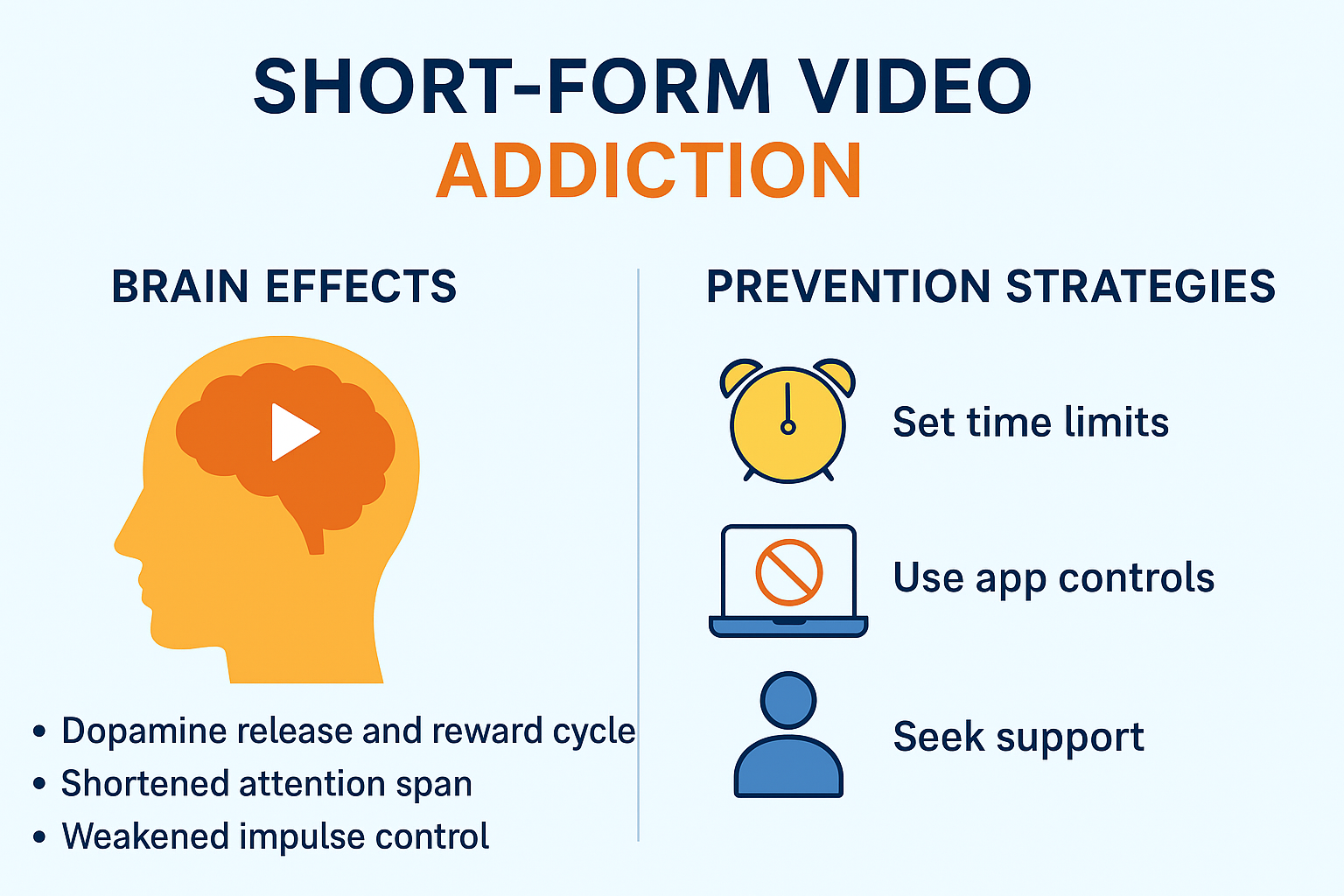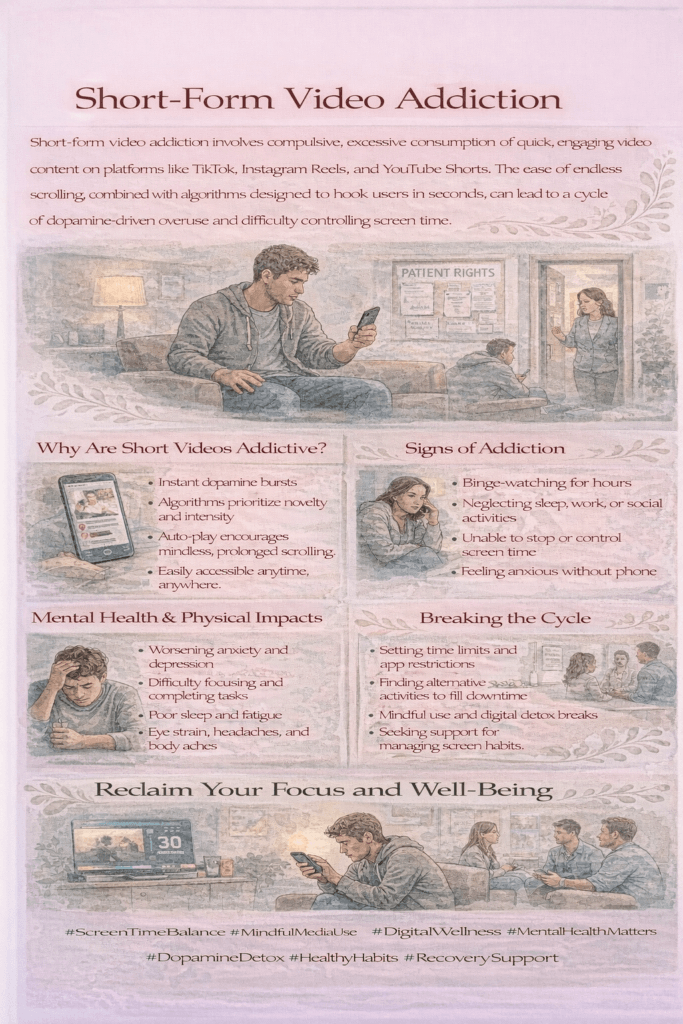Short-form video addiction involves excessive use of quick, engaging videos that stimulate dopamine release and reinforce addictive brain pathways. Preventing and managing this addiction includes self-care, like setting limits and mindful watching, family support through clear boundaries and healthy role modeling, and community resources such as education and counseling to encourage balanced technology use.
Hooked in Seconds: Understanding and Overcoming Short-Form Video Addiction
Short-form video addiction is a modern digital challenge fueled by platforms like TikTok, Instagram Reels, YouTube Shorts, and Snapchat Spotlight. These quick, highly engaging clips—often just seconds long—are designed to capture attention instantly and keep users watching for extended periods. The constant stream of novel, stimulating content activates the brain’s reward pathways, releasing dopamine and creating a cycle of craving and gratification similar to other addictive behaviors.
While these videos can be entertaining and even educational, overuse can lead to serious consequences. People may experience shorter attention spans, disrupted sleep patterns, decreased productivity, and even social withdrawal as screen time replaces in-person interactions. The ease of access and endless scroll make self-regulation challenging, especially for younger audiences.
Breaking free from short-form video addiction requires mindful usage, setting boundaries, and engaging in offline activities that provide fulfillment. Recognizing the signs early and making intentional changes can help restore balance, improve mental well-being, and ensure technology serves as a tool for enrichment rather than a trap for attention.
Rewiring the Mind: How Short-Form Videos Shape the Brain for Addiction
Short-form videos, found on platforms like TikTok, Instagram Reels, YouTube Shorts, and Snapchat Spotlight, are more than just quick entertainment—they’re powerful tools for shaping the brain’s pathways in ways that can foster addictive behaviors.
At the core is the dopamine release and reward cycle. Each short, stimulating clip—whether funny, surprising, or visually striking—triggers a surge of dopamine, the brain’s “feel-good” chemical. This reward reinforces the urge to keep watching for instant gratification. Adding to this is the variable reward schedule—you never know what the following video will bring. Like a slot machine, this unpredictability keeps the brain engaged and craving more.
However, these constant bursts of novelty can lead to short-attention-span conditioning, training the brain to expect fast, easily digestible content and making longer tasks feel more difficult. Over time, altered prefrontal cortex function—the area responsible for self-control and decision-making—can weaken, making it harder to resist the temptation to keep scrolling. Through neuroplasticity, repeated viewing rewires brain circuits, turning short-form video consumption into a habitual coping mechanism for boredom or stress.
By leveraging rapid, unpredictable, and stimulating content, short-form video platforms hijack the brain’s reward systems, making them incredibly engaging—and for some, dangerously addictive. Recognizing these brain changes is the first step toward building healthier digital habits and reclaiming focus and control.

10 Self-Management Strategies to Prevent Short-Form Video Addiction
Short-form video platforms like TikTok, Instagram Reels, YouTube Shorts, and Snapchat can be fun and engaging—but they can also become addictive. The quick dopamine hits, endless scrolling, and unpredictable content can make it hard to stop watching.
If you’re noticing that short-form videos are affecting your focus, productivity, sleep, or relationships, these self-management strategies can help you take back control.
1. Set Time Limits
- Use built-in app timers or phone settings to limit daily viewing.
- Start small, like 15–30 minutes per day, then adjust as needed.
2. Schedule Screen-Free Times
- Make specific times (meals, before bed, work hours) screen-free zones.
- Replace that time with offline activities or self-care.
3. Use App Controls and Tools
- Turn on “Do Not Disturb,” grayscale mode, or focus modes.
- Disable autoplay to avoid endless video chains.
4. Create a Distraction-Free Environment
- Keep your phone out of reach when working or socializing.
- Charge devices outside your bedroom for better sleep.
5. Practice Mindful Viewing
- Watch with intention—avoid mindless scrolling.
- Ask: “Am I watching to relax, learn, or just out of habit?”
6. Replace with Alternative Activities
- Try hobbies, exercise, reading, or social interaction instead.
- Use apps that build skills, creativity, or focus.
7. Track Usage and Reflect
- Use a journal or screen time tracker to spot patterns.
- Note how video use affects your mood, sleep, and productivity.
8. Set Clear Goals and Rewards
- Define specific screen time goals.
- Reward yourself when you hit milestones.
9. Seek Social Support
- Tell friends or family your goals for accountability.
- Join digital wellness groups for tips and encouragement.
10. Practice Digital Detoxes
- Take regular breaks from all screens—start with a few hours, then try full days.
- Use this time to reconnect with offline life.
Bottom line: By setting boundaries, replacing habits with healthier ones, and staying intentional about your screen use, you can enjoy short-form videos without letting them take over your life.
10 Proven Family Strategies to Prevent Short-Form Video Addiction in Kids and Teens
Short-form video platforms can be fun and engaging, but for children and teens, excessive use can quickly turn into a harmful habit. Family involvement is one of the most powerful tools in preventing this type of addiction. By setting healthy boundaries, modeling balanced screen use, and fostering open communication, families can help young people develop a healthier relationship with technology. Here are ten practical family support strategies to reduce the risk of short-form video addiction and promote overall digital well-being.
Family support is crucial in preventing short-form video addiction, especially for children and adolescents who are most vulnerable. Here are effective family support strategies:
1. Set Clear Boundaries and Rules
- Establish family guidelines for screen time, including limits on short-form video use.
- Consistently enforce these rules with fairness and clarity.
2. Model Healthy Behavior
- Parents and caregivers should model balanced digital habits, showing how to use technology responsibly.
- Avoid excessive phone or app use in front of children.
3. Encourage Open Communication
- Talk openly about the risks of excessive screen time and addictive content.
- Listen to children’s feelings and experiences with digital media without judgment.
4. Create Tech-Free Zones and Times
- Designate areas (like the dining table or bedrooms) and times (family meals, before bedtime) as screen-free.
- Promote face-to-face interaction during these times.
5. Engage in Shared Activities
- Plan regular family activities that don’t involve screens, such as outdoor play, board games, or hobbies.
- Use these moments to strengthen bonds and provide alternative entertainment.
6. Monitor Content and Usage
- Use parental controls and monitoring apps to track and limit access to addictive platforms.
- Discuss appropriate and inappropriate content together.
7. Support Emotional Needs
- Recognize that excessive video watching may mask boredom, loneliness, or stress.
- Offer emotional support and help develop coping skills that don’t involve screens.
8. Encourage Balanced Routines
- Help family members develop routines that balance technology use with physical activity, sleep, homework, and socializing.
9. Educate About Digital Wellness
- Share age-appropriate information on how digital content affects the brain and well-being.
- Promote awareness of addictive design features in apps.
10. Seek Professional Help if Needed
- If addictive behaviors persist or worsen, encourage assessment and support from counselors or digital addiction specialists.
10 Community Strategies to Prevent Short-Form Video Addiction
Short-form videos can be fun and engaging—but overuse can lead to compulsive scrolling, decreased attention span, and less real-world connection. Communities play a vital role in preventing these problems by offering education, support, and healthier alternatives. Below are ten effective community resource strategies to help individuals and families manage and prevent short-form video addiction.
1. Digital Literacy and Awareness Programs
- Host workshops in schools, libraries, and community centers to teach about the risks of excessive screen time and addictive app design.
- Encourage healthy digital habits and critical thinking about media use.
2. Youth Engagement and Activity Centers
- Provide safe, supervised spaces where young people can enjoy sports, arts, clubs, and social events as fun alternatives to screen time.
- Offer programs that promote creativity, teamwork, and face-to-face interaction.
3. Mental Health and Counseling Services
- Ensure access to counselors trained in behavioral addictions and digital wellness.
- Offer group therapy or peer support groups for those struggling with compulsive digital use.
4. Parent and Caregiver Support Groups
- Create support networks for parents to share strategies and get guidance on managing children’s screen habits.
- Provide tools for setting boundaries and spotting early warning signs of addiction.
5. School-Based Prevention Programs
- Integrate digital wellness education into health classes or advisory periods.
- Train teachers to recognize signs of problematic screen use and intervene early.
6. Technology-Free Community Events
- Organize “tech-free” days, outdoor festivals, or game nights to encourage offline socialization.
- Promote awareness about the benefits of unplugging.
7. Access to Recreational Facilities
- Invest in public parks, gyms, and recreational centers that offer healthy activities for all ages.
- Reduce financial barriers by offering affordable or free access.
8. Collaboration with Tech Companies
- Support local policies urging app developers to include built-in usage limits and wellness tools.
- Partner with platforms to promote responsible use and awareness campaigns.
9. Public Health Campaigns
- Use local media and outreach to highlight the risks of short-form video addiction.
- Share real-life stories to reduce stigma and encourage people to seek help.
10. Peer Mentorship and Youth Leadership
- Develop youth-led digital wellness initiatives where teens mentor peers on healthy tech habits.
- Empower young leaders to advocate for balanced use of technology.
In summary, when communities unite around education, healthy alternatives, and strong support networks, they create an environment where short-form video addiction is less likely to take root. These strategies not only protect digital well-being but also foster more meaningful offline connections.
Frequently Asked Questions
Here are some common questions:
Question: Provide an infographic about brain effects and prevention strategies.
Answer:

Question: What government strategies to decrease short-term video addiction?
Answer: Governments could address short-form video addiction much like they’ve tackled other public health and behavioral issues (e.g., gambling, tobacco, gaming) — combining regulation, public education, and industry accountability.
Here are key strategies:
1. Public Awareness & Education Campaigns
- Launch nationwide campaigns about the risks of excessive short-form video use, similar to anti-smoking or digital literacy initiatives.
- Partner with schools to integrate digital wellness education into curricula, teaching students about the impact on attention span, mental health, and sleep.
- Create online resources for parents, teachers, and youth workers.
2. Age-Appropriate Restrictions
- Enforce minimum age requirements for platform use and implement stricter verification.
- Limit autoplay or algorithm-driven recommendations for underage users.
- Require clear “screen time” warnings or usage reminders for minors.
3. Platform Regulation
- Mandate “digital wellbeing” features—such as break reminders, time tracking, or screen time caps—by law.
- Restrict addictive design elements, like infinite scrolling or variable reward algorithms, especially for minors.
- Require platforms to offer chronological feeds rather than purely algorithmic ones.
4. Research Funding & Data Transparency
- Fund independent research into the long-term effects of short-form video use.
- Require platforms to share anonymized usage data with public health researchers to monitor patterns and addiction risks.
5. Mental Health Integration
- Train healthcare providers to screen for excessive use of short-form video during routine check-ups.
- Provide funding for digital addiction treatment programs within public health systems.
6. Parental Support Programs
- Create free digital parenting workshops funded by public health departments.
- Offer subsidies for parental control tools or software that help manage children’s screen time.
7. Workplace & Community Policies
- Provide community centers with alternative engagement activities for youth (sports, arts, volunteering) as healthy substitutes for excessive online time.
- Encourage employers to promote digital balance through wellness programs.
Question: What are the advantages of the Short-form video format to society?
Answer: Short-form video formats—like TikTok, Instagram Reels, and YouTube Shorts—have rapidly become a dominant way people consume content. While much discussion focuses on their risks, there are several notable advantages these formats offer to society:
1. Rapid Awareness and Mobilization
In social activism, short videos have been effective in raising awareness quickly, spreading messages about important issues, and mobilizing grassroots efforts.
2. Quick and Accessible Information Sharing
Short videos can distill complex ideas into bite-sized, easy-to-understand content. This makes educational material, news updates, and public service announcements more accessible to broad audiences, including those with limited attention spans or less time.
3. Enhanced Creativity and Self-Expression
These platforms encourage creativity through editing tools, music, and effects, empowering users to express themselves in unique ways. This can foster cultural exchange, art, and innovation at a grassroots level.
4. Democratization of Content Creation
Anyone with a smartphone can create and share content without needing expensive equipment or traditional gatekeepers (like TV studios or publishers). This levels the playing field, amplifying diverse voices and perspectives.
5. Community Building and Social Connection
Short videos often spark trends, challenges, and conversations that connect people globally around shared interests, humor, and social causes, creating micro-communities and social cohesion.
6. Entertainment and Stress Relief
Their quick, engaging nature provides easily digestible entertainment that can boost mood and offer brief mental breaks, contributing positively to mental health when used in moderation.
7. Marketing and Economic Opportunities
They open new avenues for small businesses, influencers, and creators to promote products, build brands, and generate income, contributing to economic activity and entrepreneurship.
Conclusion
Short-form video addiction impacts brain reward pathways, making users prone to compulsive viewing and difficulty controlling usage. Effective prevention and recovery require a combination of self-management strategies, supportive family involvement, and access to community resources. Together, these approaches help individuals regain control, build healthier habits, and reduce the risk of addiction in today’s digital environment.
Video: Is Your Brain Hooked On Scrolling?

